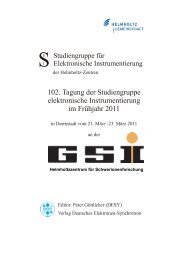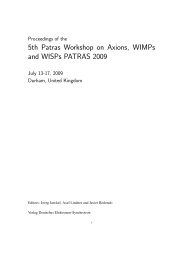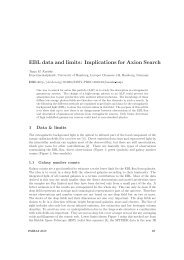Hamburg Neutrinos from Supernova Explosions ... - DESY Library
Hamburg Neutrinos from Supernova Explosions ... - DESY Library
Hamburg Neutrinos from Supernova Explosions ... - DESY Library
Create successful ePaper yourself
Turn your PDF publications into a flip-book with our unique Google optimized e-Paper software.
E2<br />
GW amplitude A [cm]<br />
20<br />
50<br />
0<br />
-50<br />
BERNHARD MÜLLER, HANS-THOMAS JANKA, ANDREAS MAREK, FLORIAN HANKE, . . .<br />
prompt<br />
convection<br />
matter signal<br />
neutrino signal / 5<br />
stochastic signal<br />
(hot-bubble convection)<br />
enhanced<br />
SASI activity<br />
asymmetric shock<br />
expansion<br />
+PNS convection<br />
0 0.1 0.2 0.3 0.4 0.5 0.6 0.7<br />
time after bounce [s]<br />
dE/df [erg/Hz]<br />
10 43<br />
10 42<br />
10 41<br />
10 40<br />
GR<br />
effective potential<br />
Newtonian<br />
100 1000<br />
Frequency [Hz]<br />
Figure 4: (color online) Left: Matter (black) and neutrino (light brown) gravitational wave<br />
signals for the general relativistic 15M⊙ explosion model. Right: Influence of the treatment of<br />
gravity (black: GR hydro, red: Newtonian hydro + effective potential, blue: purely Newtonian)<br />
on the gravitational wave energy spectrum for the first 500 ms of the post-bounce evolution of<br />
the 15M⊙ progenitor.<br />
variations in the neutrino flux (particularly in νe and ¯νe , see Fig. 3, right panels) that have<br />
been discussed in [17, 32, 33, 34] and can potentially be used to extract the frequencies of the<br />
SASI <strong>from</strong> the neutrino signal using detectors with high temporal resolution such as Icecube<br />
[33]. In our simulations, these fluctuations are present in similar strength as in Newtonian and<br />
effective potential models [17, 32, 34] with the hemispheric flux fluctuating by several tens of<br />
percent; and the dominant frequencies (45 Hz and 75 Hz for the ℓ = 1 and ℓ = 2 mode) are in<br />
excellent agreement with [32, 33].<br />
It is interesting to note that our results suggest that the neutrino signal changes its character<br />
only gradually over several hundreds of milliseconds after the onset of the explosion. The<br />
temporal fluctuations are actually strongest during the first ∼ 200 ms after shock revival, and<br />
the luminosities of νe and ¯νe do not show any abrupt decline correlated with the time of the<br />
explosion. This behavior is in marked contrast to the abrupt drop in the νe and ¯νe luminosities<br />
in 1D models with artificial explosions [35], and is due to the fact that quite large accretion rates<br />
can still be maintained through the downflows at late times in multi-dimensional models (Fig. 2).<br />
As long as the shock does not expand too rapidly, new downflows may still form and channel<br />
fresh material into the cooling region (see [6], as in the case of the 11.2M⊙ progenitor, which<br />
leads to noticeable “bumps” in the neutrino luminosity (Fig. 3, top left panel). For the 15M⊙<br />
progenitor, an even higher accretion luminosity can be maintained continuously because of the<br />
presence of a stable polar downflow in an extremely asymmetric explosion geometry (Fig. 2).<br />
With a single downflow, the neutrino emission exhibits a strong directional dependence with<br />
sustained hemispheric flux differences of up to several tens of percent (Fig. 3). On the other<br />
hand, the strong high-frequency fluctuations subside during the late phases as the expansion of<br />
the shock quenches further SASI activity. The neutrino signal thus still reflects the dynamical<br />
evolution of explosion models in multi-D, albeit in a form very different <strong>from</strong> artificial 1D<br />
explosions.<br />
Naturally, the determination of gravitational wave signals has also been among the major<br />
goals of the simulations with the relativistic version of Vertex. Qualitatively, we obtain similar<br />
waveforms as computed in the Newtonian or effective potential approximation [32, 36, 37]<br />
18 HAνSE 2011<br />
5








